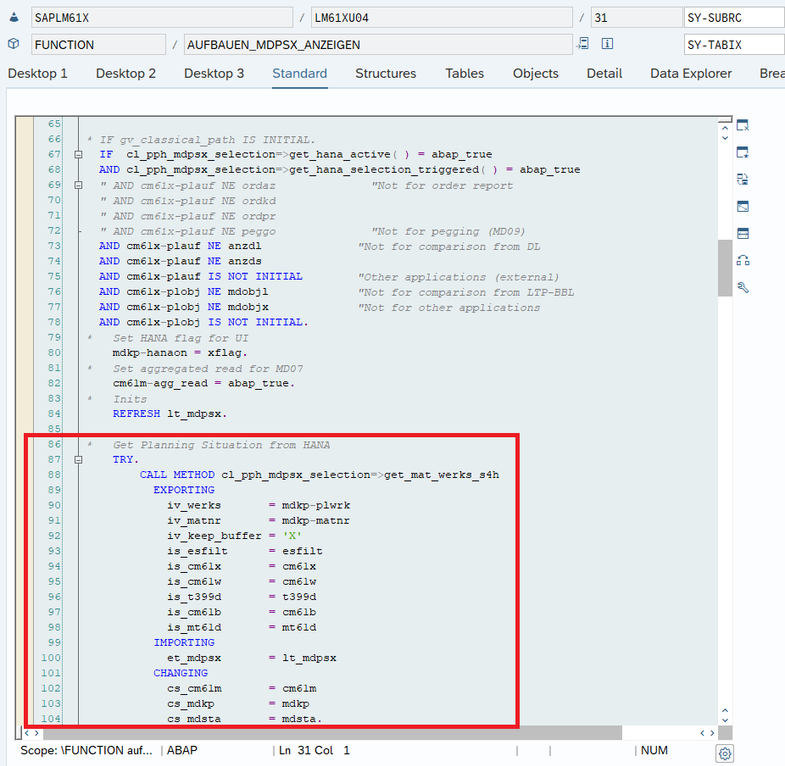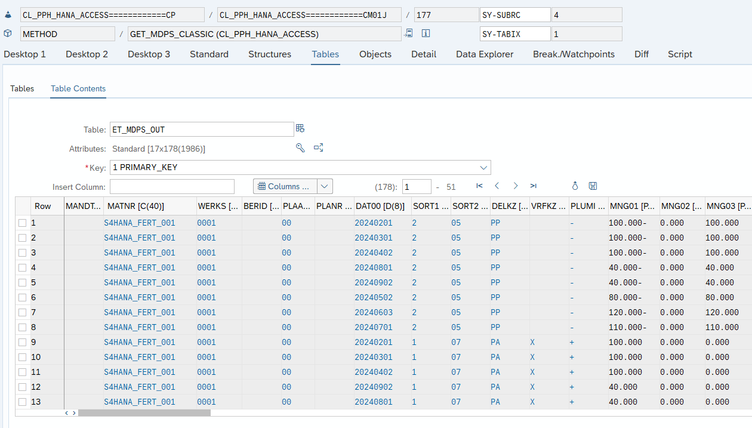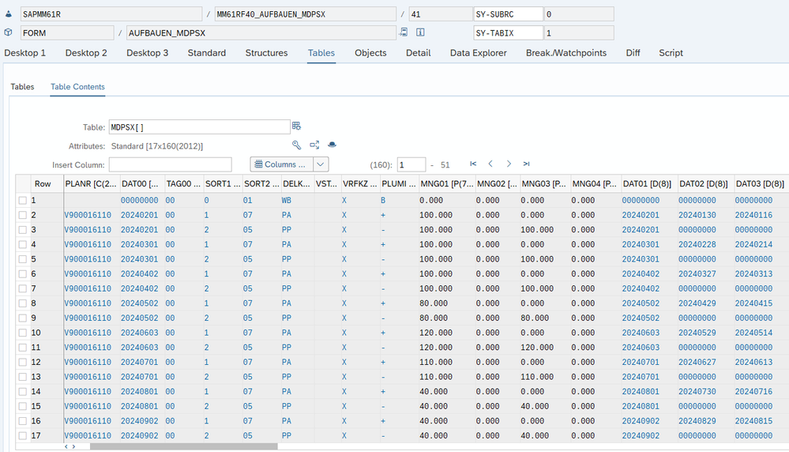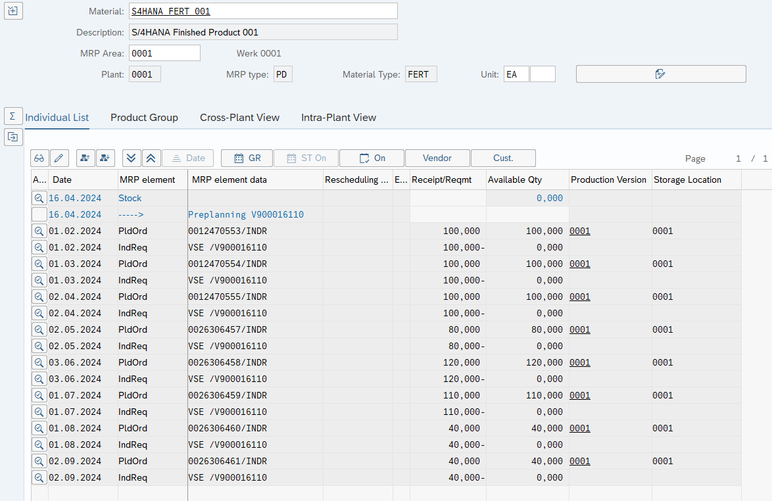
- SAP Community
- Products and Technology
- Enterprise Resource Planning
- ERP Blogs by SAP
- Debugging transaction MD04 in SAP S/4HANA
- Subscribe to RSS Feed
- Mark as New
- Mark as Read
- Bookmark
- Subscribe
- Printer Friendly Page
- Report Inappropriate Content
Back in 2014 I wrote the blog How to analyze transaction MD04 in debug, which explained how we could analyze the execution of the Stock/Requirements List (transaction MD04) in debug mode, in order to understand which how is selected and resolve common issues that might affect the MRP elements displayed in MD04.
In 2015, however, SAP S/4HANA was introduced and the logic to select the planning elements from the database in the Stock/Requirements List was redesigned for a better performance on the HANA database. While the old blog is still relevant for debugging transaction MD04 in SAP ECC, this new blog explains how to debug MD04 in an SAP S/4HANA system.
We can use debugger to understand, for example, why a certain element exists in the database but it is not displayed in MD04, why an MRP element is not relevant for MRP or why it is displayed with a different quantity.
The starting point to debug MD04 in an SAP S/4HANA system is still function module AUFBAUEN_MDPSX_ANZEIGEN; however, instead of calling different procedures where MRP elements are sequentially selected from the database and processed by an ABAP code, method GET_MAT_WERKS_S4H of class CL_PPH_MDPSX_SELECTION will be called, as shown in the figure below.

Inside this method, a HANA stored procedure will be called to read the all the MRP elements from the database at once, taking advantage of HANA internal parallelism. In the following figure we can see the details of the stored procedure that is called, however, we won’t be able to debug the AMDP execution in the ABAP debugger.

After the execution of the AMDP procedure, system will collect the MRP elements read from the database and build the internal table ET_MDPS_OUT. This internal table will contain all the MRP elements that were selected from the database and that might be relevant to MRP. We can see in the figure below that 17 records were selected from the database. Here is the first point that we can check to determine if a planning element was originally selected from the database or not.

With the internal table populated with the MRP elements, system will call method FINALIZE_MDPSX_CDS of class CL_PPH_MDPSX_POSTPROCESSING, in order to determine if a planning element should be really displayed in MD04 and determine additional settings. In the following figure we can see the piece of code where system determines whether an MRP element is available for MRP and the firming indicator, for example (note that all comments are in English, so we can easily understand what is happening inside each call).

After the execution of this method, we will come back to the old function module AUFBAUEN_MDPSX_ANZEIGEN, and the old table MDPSX will be populated with the MRP elements. The following pictures show the contents of internal table MDPSX after the execution of function module AUFBAUEN_MDPSX_ANZEIGEN and the results displayed in transaction MD04, and as we can see in the pictures, both are very similar.


As we mentioned earlier, the logic to select the MRP elements from the database has been completely rewritten and the data selection has been pushed into the HANA layer. It means that old ABAP BAdIs that were previously called when reading the MRP elements from the database will no longer be called. This is the case, for example, of BAdI MD_CHANGE_MRP_DATA, which was commonly used in SAP ECC to manipulate the MRP elements in the Stock/Requirements List. As an alternative, we can use the ABAP BAdI MD_ADD_ELEMENTS, which can be for the same purpose. As of SAP S/4HANA 2022, we can also use the new AMDP BAdI PPH_SUPPLY_DEMAND_LIST, which is also called by MRP Live and the MRP Fiori Apps. This blog provides more details about this BAdI.
Finally, there are situations where we might still want to have the old logic ABAP triggered when troubleshooting an issue. This is the case, for example, if we think that there is a bug in the new logic and we want to compare it with the old one. We can force MD04 to use the old logic by typing HANA_OFF in the command field, and HANA_ON to make sure that the new logic is used. Note that this should only use used for troubleshooting, not as part of the daily usage of MD04.

After we finish reading the MRP elements from the database, we continue with the same flow that previously executed in SAP ECC. The following function modules, mentioned in the previous blog, are still relevant in SAP S/4HANA:
- MD_GET_KUND: Read customer information for sales orders;
- MD_GET_LIEF: Read vendor information;
- MDEZX_AUFBAUEN: Build the MRP elements texts, as they are displayed on the screen;
- MDSUX_AUFBAUEN: Build the MD04 period totals;
Brought to you by the SAP S/4HANA RIG
You must be a registered user to add a comment. If you've already registered, sign in. Otherwise, register and sign in.
-
Artificial Intelligence (AI)
1 -
Business Trends
363 -
Business Trends
25 -
Customer COE Basics and Fundamentals
1 -
Digital Transformation with Cloud ERP (DT)
1 -
Event Information
461 -
Event Information
25 -
Expert Insights
114 -
Expert Insights
166 -
General
1 -
Governance and Organization
1 -
Introduction
1 -
Life at SAP
415 -
Life at SAP
2 -
Product Updates
4,684 -
Product Updates
239 -
Roadmap and Strategy
1 -
Technology Updates
1,501 -
Technology Updates
89
- How to check if a note is applied in S4HANA Public Cloud? in Enterprise Resource Planning Q&A
- Flexible Forecast consumption BADI not working in Enterprise Resource Planning Q&A
- Business Rule Framework Plus(BRF+) in Enterprise Resource Planning Blogs by Members
- BAPI_PR_CHANGE is not updating Service Component of PR in Enterprise Resource Planning Q&A
| User | Count |
|---|---|
| 17 | |
| 11 | |
| 7 | |
| 5 | |
| 4 | |
| 4 | |
| 3 | |
| 3 | |
| 3 | |
| 2 |